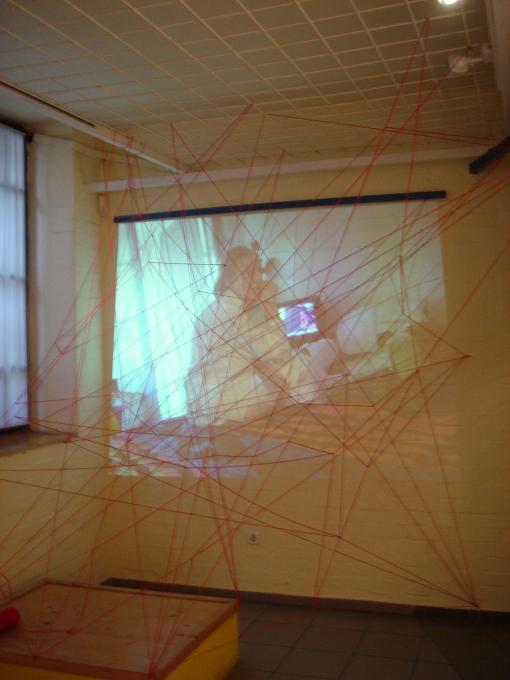Costume Textile Project-Beata Szechy installation
Beata Szechy
Costume Textile Project
exhibition at
Ferencvarosi Gallery
IX. Mester u. 5. Budapest, Hungary
Opening remarks by Wehner Tibor
THREADS: Beata Szechy's Exhibition, Ferencvarosi Gallery, Budapest
The videos, installation pieces and traditional technique prints compose this exhibition. The installation is a continuation of Beata Szechy's earlier works and subject matter. Szechy started her artistic career almost thirty years ago. The early period of her works included concepts of legacy, symbolism and avant-garde combinations of visual elements. Traditions and subject matter, the unusual, and realism float together while simultaneously breaking apart from each other. In this way, Szechy has created a special style and meaning in her work.
The traditional printing techniques and photographs, the book objects, and the installations function together as pieces of a puzzle that fill the gallery space. In her early work during the 1980's, Szechy began to use thread as part of her work, as she uses now here in this exhibition. The thread holds meaning. It is a line or drawing on the paper, sometimes as geometric shapes, sometimes as a zigzags, sometimes as tangled threads.
The yarn and thread has symbolic meaning in history. The thread is a symbol of the world axle in the Hindu concept of Brahma, in which everything is interconnected. The use of thread also symbolizes the knowledge in Buddihism as well as representing creatures that appear in sacred documents related to these religions. Another reference of this thread points to Greek mythology, in which Adrienne's thread helps Theseus find the way out from a labyrinth. The thread symbolizes the only right way to go. Finally, the thread represents human fate and the end of life. The thread, when pulled off from the bobbin, symbolizes life, but the broken thread symbolizes death.
In her work in the Ferencvarosi Gallery, Szechy uses all of the above elements, combining them into one installation piece where yarn, thread, sewing machine stitches, historical documentation, family memories and photographs demonstrate how time passes. The memories of the artist, the discovery of self, and the force of these findings in the special refraction of lights parallels the fate of the artist's life.
In addition to her photo collage and three-dimensional work, Szechy's silk screen prints, with their colorful compositions, the prints use different texture, curtain and carpet motifs on the paper.
Beata Szechy moved to the United States in the mid 1980's. Returning frequently to her home in Hungary, she has had the opportunity to work in both countries. These objective facts: exile and homecoming, the research of her roots and the desire to save them are reflected in her artwork.
In Szechy's work, the idea of truth, representational figures and the visual abstractions, and symbolic moments all refer to the element of time. It is the inconsiderate passing of time and illusion of the luck of time that Beata Szechy captures in her work. This element of time is neutralized and hidden in the motifs. The facts are documentations: the indispensable buffer with the steady, the concrete with the regular, the light with mystery.
The single prints and diptychs are sometimes geometric abstractions, sometimes organic. The visual motifs cover the whole surface. These works bring us into a labyrinth, from where we hope the threads can free us. Of course, this interpretation is just a theory, a subjective explanation. Szechy's works may also exist as purely decorative forms and compositions that reveal a hidden world of secret beauty.
Three years ago, at the Ernst Museum in Budapest, Szechy presented a retrospective exhibit. In this exhibition, she presented a quote from her book: "I have started somewhere. I made a circle and arrived to the starting point. For some reason it had to happen this way." In this sense, Beata Szechy's art symbolizes her life cycle. When we have arrived somewhere, we say a friendly hello to ourself, with a great sense of understanding.
Tibor Wehner
(Opening reception on May 29, 2008)
- bszechy's blog
- Login to post comments



